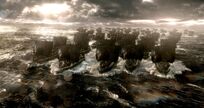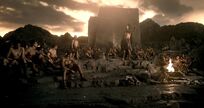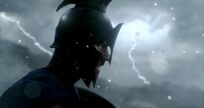At first it passed through the air gap, stroking the strands of hair as tenderly as a lover, and then it whipped up swift words that symbolized freedom and accompanied sacrifice.
The story begins with the narration of the Spartan queen, narrating the follow-up story about Themistokeri (hereinafter referred to as Demi) and the "Battle of Marathon" that happened outside the 300 Spartan warriors. Legend has it that Deimi killed King Darius at the Battle of the Beach, but spared Xerxes, who would later call himself "King of Kings". This story gave the Persian side a very long narrative. With the half-baked lesson of the prequel, this time director Zach Snyder spent more time on the narrative, first dragging the timeline in the narration, and then bringing out the Several main characters, and then put forward a few paragraphs of what happened, sew a piece of foreshadowing and make Artemia (ie Themesia) and Demi more flesh and blood, when the story progresses to the prequel that is 300 Sparta At the time when the warrior died, Dimi went to the land of Spartan heroes for the second time to seek the naval assistance of the Queen of Sparta, and took the sword of the fallen king Leonidas with him. The ending, as always, begins with an epic naval battle with many enemies and few enemies. With the arrival of the Spartan queen's vengeance sailboat, Artemia is killed in front of Dimi, and Xerxes turns around and walks towards the darkness of the Persian army, and the story ends.
If we don't overplay Dimi's personal leadership, the story will be even more exciting. I don't know if it is because the creators feel that the role of Artemia is not strong enough, so they have prepared two opportunities for Dimi to "pre-war lectures". From a fair point of view, Dimi's leadership qualities have been over-consumed. Artemia is a woman who endured enormous humiliation and physical torment, and the scene where she kisses the head of a dead man may give the viewer a superficial first impression, but there is actually a hidden symbol that this woman and the god of death For Wu. Immediately afterwards, there were many scenes of ruthlessness prepared for the French girl, including the "fight" with Demi in the cabin. I think any aspiring actress will not hesitate to put in these scenes for Artemia. Going inside, Ava earns herself a chance to prove that French actresses don't just have a soft side.
What follows is a short history lesson to help you get more involved in the film - the
story tells that Xerxes, who is devastated by the loss of his father, accepts Artemia's plan, is smeared with strange drugs, and then Go to the desert. This is in line with the mythological implication of trial and rebirth in religion. Originally, the scene of the three hundred warriors had a mythological color, which made it less abrupt for Xerxes to become a golden "God King" later.
King Darius is the historical king of Persia. The Persian Empire he built was a highly centralized monarchy, creating a historical miracle that the country's territory spanned Europe, Asia and Africa. The Persian Navy and the Persian Army shown in the film are actually huge in number. It comes from the war slavery practiced in this country, and every time a place is conquered, new labor force and new combat power are obtained. In the story, Artemia said that he stood among 10,000 people but felt lonely. Artemia was originally a Greek and was brought back to the Persian kingdom by the Persian messenger after suffering. The reigning King of Persia has a million-strong army, but he has a sparse military heart or no military heart at all. Therefore, to fight a war, he must terrorize his troops and slaves with death.
Let’s look at the navy of Artemia. She controls the maritime forces of the Persian state. Their ships are actually no different from the ships used by the Athenian navy in Dimi. They are all low-level ships that rely on oars to move, but the hull and The number of ships carried far exceeds that of the Athenian Navy. Because Persia has more slaves, slaves do not have to fight (the oars of the Greek Navy are also soldiers), so the Persian ships are larger and more powerful, commonly known as "coolies".
As a sailing enthusiast, let's continue to take a look at the "Vengeance Fleet" of the Queen of Sparta. The ships used by the Athenian Navy are more like enlarged rafts, which cannot cope with the weather in the Aegean Sea. The sound of seagulls can always be heard in the fighting area, which means being close to land. But the Spartan Queen's fleet looks more like a Viking's voyage ship, belonging to a single sailing ship. In the story, the surging momentum and roar of the Spartan Queen's army when the army arrives is not just the soundtrack. A little bit, that's because no one on the boat is paddling, and the power is entirely dependent on the sea breeze, so at the moment when the hull collides, the Spartans can do their best to swallow their opponents like a lion.
After analyzing the ship, let's look at the "damage". There are a lot of "Z solution" scenes in the two films of the Three Hundred Warriors, which may seem incredible, but they are actually historically sophisticated. In ancient times, the war was much more cruel than it is now. It is possible that after the first enemy fell, the soldiers would still feel afraid or pray for their own lives, but if the same person killed the second enemy, that person would face the third enemy. When the enemy becomes a demon. This has nothing to do with mysticism or religion. This is the mystery of the human body. Adrenaline not only numbs the pain, but also numbs the brain, allowing the brain to focus all its attention on the fist and the three-meter range in front of the eyes. This is the wild instinct of human beings. moment of explosion. The sword hurts the opponent's body. In the film, it is done in one go. . There are ancient philosophies that the origin of culture is not thinking, but actually killing. The nature of human beings or the nature of nature is that "death brings life". This process is very cruel. At one point, human beings compiled myths, which in turn produced religious civilization, and then culture.
Sparta is known as "the land of heroes", meaning the place where the greatest warriors of mankind were born. It can be seen that there are two absolutely with steel, muscle + hero. Hero here refers to a war culture that spread through Sparta, and their lofty ideals believed that war was the only way to drive out barbarians. They disliked the Athenians, believing that true democracy and freedom required the sacrifice of flesh and blood, rather than a war of words. Americans love stories of war and democracy, because Washington, the father of the nation, built the country between the two, and it is worth mentioning that the United States was the first country on the planet to build a country with "reason" (and then there was one, that China), the Athenians argued that it was because they lacked "reason", anyone with "reason" would agree with the Spartan philosophy of war, that there must be sacrifice in order to make peace, and the Spartan warriors were for Sacrifice and live. Now you can see that Greek philosophy is widely circulated in the world. In fact, it is mostly because it has two powerful admirers.
Xerxes once again proved that he had the ability to roar, and he did not have the strength to fight on the battlefield. In this story, he still did not see his golden body fighting on the battlefield. Some people may ask why the Persian army lost, it's too fake, the first one didn't lose. The Persian army is known for its infantry and cavalry. At this point, the only opponent of King Darius may be the iron horse cavalry of Genghis Khan. It can be seen that the story has added strange and powerful arms such as elephants and giants to the Persian army. This is a symbol that tells the viewer that in that period of history, the Persian army was invincible on land (cavalry, elephant soldiers, and giants were all unable to cross the sea). The main battlefield in the second story is the Aegean Sea, which is the weakness of the Persian army. Even with the most powerful troops, only infantrymen can go out to sea. Stay on the technical level of wood pulp boats. This also explains to a large extent why Persia can't beat Greece, and it also provides logical support for the battles in the story with less and more. After witnessing this history on the screen, the next time I go to the Aegean Sea, I will Take the time to listen to the sea breeze from the sea, no wonder the Greeks love that sea, the strongest shield to protect their history and freedom and democracy.
Viewers who regard the Three Hundred Warriors as "cool movies" should keep their eyes open. In fact, there is a lot of background knowledge worth exploring in the story. This story revolves around the theme of "sacrifice and democracy", using the Spartan philosophy of war to try to bring viewers living in the electronic age, visual impact and historical echoes, with a mythical and legendary violence aesthetics to start a truth discussion: I I die or I die. "rather die on our feet not die on our knees" Sparta and the Athenian warriors handed over the eternal answer with flesh and blood, they would rather I die than die.
It is hoped that the trend of historical dramas brought by Viking legends can open up Greek historical dramas. This is a magical land. They are many years earlier than other lands. They figured out that the smartest people in this world are not gods, but people who are constantly seeking knowledge. There are the brightest and most learned philosophers, and there are the toughest and greatest iron warriors. "300 Warriors: The Rise of the Empire" is a great sequel. I recommend you to watch and collect it. In fact, the title suffix should be changed to rise of freedom or the wind of freedom, which may be more appropriate.
View more about 300: Rise of an Empire reviews











